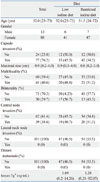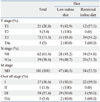Although there have been differing opinions regarding treatments for differentiated thyroid carcinoma, many institutes perform radioiodine ablation therapy after a total thyroidectomy.
13 Radioiodine ablation therapy with an application of
131I has been utilized to treat or examine residual thyroid tissue or metastasized thyroid carcinoma after a total thyroidectomy since Keston, et al.
14 reported that radioiodine is consumed in tissues in which differentiated thyroid carcinoma had metastasized.
15 To increase radioiodine uptake, thyroid-stimulating hormone (TSH) range can be increased by stopping thyroid hormone therapy or by injecting recombinant human TSH (rhTSH). Moreover, by decreasing the concentration of iodine through a LID, the sensitivity of residual thyroid tissues toward TSH can be increased. In turn, consumption of radioiodine can be increased. Moreover, by increasing sodium iodide symporter (hNIS), specific activity of radioiodine can be increased.
16,
17 Residents in regions lacking iodine have a daily urine iodine (I/Cr) of <50 ug/gCr on average, while people living in areas with a normal amount of iodine consumption show >100 ug/gCr. Hence, many institutions consider daily urine iodine (I/Cr) <50 ug/gCr amounts as the optimal figure for measurement when a patient undergoes radioiodine ablation therapy. Meanwhile, Park and Hennessey
18 estimated a range as high as <100 ug/gCr as appropriate.
19,
20 Many institutions limit the daily amount of iodine consumption to <50 ug for a LID and 50-100 ug for a RID prior to radioiodine ablation therapy.
21 According to the recommendations published by the ATA in 2006, the restricted diet should be implemented 1-2 weeks before radioiodine ablation therapy.
6 In Korea's case, however, people consume 468.9 ug on average, which is more than the average consumption of iodine per day for Americans (195 ug), and almost identical to the average amount consumed by Japanese, at 544 ug.
7,
22,
23 Moreover, Koreans are exposed to relatively more food with high iodine content such as seaweed and fish. Accordingly, rather than following the recommendations of the ATA, many institutions actually apply a longer duration to the restricted diet, considering the characteristics of Korea. Regarding restricted diets, because Koreans and Japanese normally enjoy meals that are high in iodine, LID causes considerable discomfort to patients in terms of their quality of life. Thus, some studies on RIDs have been published in Korea and Japan.
8,
9 We prepared meal plans for RIDs and LIDs that are suitable for conditions in Korea by requesting the Research Institute of Foods and Nutritional Science at Yonsei University. For the durations of the restricted diets, the analyses were conducted for 2 and 4 weeks, which are used mostly in Korean institutions, not based on 1- and 2-week diets in foreign cases. In general, to measure urine iodine (I/Cr), urine is collected in the morning on the day of hospitalization for radioiodine ablation therapy, or urine collected by the patient over a period of 24 hours is used. Research thus far has used the urine produced in the morning on the day of the procedure instead of the 24-hour concentrated urine in order to measure I/Cr due to the objections of patients; however, because the output of iodine to urine strongly depends on the iodine concentration in the blood for the urine in the morning sample, it is difficult to measure the amount of I/Cr as precisely as with the 24-hour concentrated urine.
24,
25 In this study, we strictly trained patients to visit the hospital and deliver 24-hour concentrated urine on the 2nd and 4th week of the restricted diets. The urine iodine calculation was calculated by dividing it with the amount of creatinine. As the measured amount can differ according to individual body water contents when using urine iodine that is not revised by creatinine, it is not easy to differentiate if the figure truelly reflects the amount of iodine in the body. Thus, it should be revised by urine creatinine.
18,
24 Urine creatinine can differ according to gender and age. In general, given that men and the young have more muscle tissue than women and the elderly, urine I/Cr tends to increase with age, and women tend to have higher figures than to men.
26,
27 In the present study, the ratio of males to females was 1:6.8 and the average age was 53 (range: 23-72) for the LID group, whereas the ratio of males to females was 1:6.7 and the average age was 51.5 (24-72) for the RID group; there was no statistical difference between the two. Hence, statistical bias can be minimized. One possible problem when selecting research subjects was that the volume of residual thyroid tissues can be slightly different because the operation methods can vary according to the institution in the case of cooperative research at multiple institutions. This can cause statistical bias. We conducted our research with patients undergoing surgeries with the same operation methods at a single institution, which should minimize statistical prejudice. To compare the amount of urine I/Cr, the amounts at the 2nd and 4th weeks were compared for each group. In the LID group, the average amount of urine I/Cr for the 2nd and 4th weeks were 28.6 ug/gCr (3.7-107) and 35.0 ug/gCr (3.5-185.9), respectively, showing a rather lower I/Cr average amount for a 2-week restricted diet, but with no statistical meaning. The amount of urine I/Cr was >100 ug/gCr in one case of the 2-week restricted diet and in two cases of the 4-week restricted diet. This might have occurred because the average amount of urine creatinine was 110 mg/dL (11.7-452.7) for the 2-week restricted diet, which is higher than the figure of 94.3 mg/dL (19.7-419.5) for the 4-week restricted diet. However, it should be considered that compliance for some of the patients decreased as the duration of the diet was extended. In the RID group, the average amounts of urine I/Cr measured at the 2nd and the 4th week were 35.8 ug/gCr (3.7-142.3) and 35.0 ug/gCr (1.9-152.6), showing a slightly lower amount for the 4-week restricted diet, but this had no statistical importance. This arose because the average amount of urine creatinine for the 2-week diet was 103.1 mg/dL (11.1-378.7), which was less than that of the 4-week diet, at 112.9 mg/dL (11.6-452.7). The amount of urine I/Cr was >100 ug/gCr for four cases in the 2-week restricted diet group and two casesin the 4-week restricted diet group. The LID figure for amount of urine I/Cr was less in the 2-week restricted diet than the RID, whereas in the 4-week diet, the two groups showed same amount. However, both figures were included in the range of <50 ug/gCr, which is the required amount for radioiodine ablation therapy. I-131 whole body scan was performed once at 2 days after I-131 administration, and thyroid uptake was performed at 2 hours and 24 hours after I-131 administration, with both showing no statistical gaps. The amount of radioiodine consumption was calculated using gamma-rays from the regions where the thyroids were removed, based on the thigh data after a request to the Department of Nuclear Medicine of Severance Hospital at Yonsei University. Results showed no statistical differences in the amounts of urine I/Cr or urine creatinine in each group between the 2-week and 4-week restricted diet groups, and no differences between the RID and LID groups. Moreover, as for the amounts of radioiodine consumption for a 4-week restricted diet, the two groups did not show a difference. Therefore, with systematic education for the patients, RID for 2 weeks can be considered for radioiodine ablation therapy after a total thyroidectomy. Moreover, it is expected that this may improve patient quality of life. In this study, the consumption amount was measured only for a 4-week restricted diet. Rather than conducting research with different patients and dividing them into 2-week and 4-week restricted diet groups, we thought it to be more accurate to work with the same patients. Moreover, if they were to be included in the range of optimal figures for treatment with little difference in urine I/Cr, we considered that the gap in the amount of radioiodine consumption would not be significant. Although patients with progressive or relapsing thyroid carcinoma were excluded, we hope that the RID can be expanded by analyzing the prognosis related to a restricted diet through monitoring of research subjects in the future.
In this study, the amounts of urine iodine and urine creatinine were compared and analyzed by setting 2-week and 4-week diet durations for the LID and RID group, and there were no differences between the durations; a comparison between the two diets also showed no differences. The two diets did not show any difference in the amounts of radioiodine consumption for a 4-week restricted diet. Therefore, when developing an adaptability plan for patients using the LID for radioiodine ablation therapy, it is reasonable to consider a 2-week RID after ensuring strict education for the patients, in order to improve their quality of life.
Furthermore, if patients do not receive proper diet education, they may proceed with ambiguous iodine restriction between the RID and LID. For the application of the RID in a clinical setting, the importance of thorough patient education cannot be overemphasized.
This is a preliminary study showing that 4-week LID and RID are unnecessary. Although we did not apply objective method to analyzing the quality of life, it is quite possible that it made patient's quality of life worse.
In extension of this preliminary results, we are in a process to compar 1-week vs. 2-week according to restricted diet method and to obtain objective data to recommend application in clinical setting, including the method of analyzing the quality of life.









 PDF
PDF ePub
ePub Citation
Citation Print
Print



 XML Download
XML Download